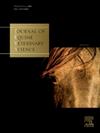Anti Mullerian Hormone as a potential biomarker of stallions fertility
IF 1.3
3区 农林科学
Q2 VETERINARY SCIENCES
引用次数: 0
Abstract
Anti-Müllerian hormone (AMH) is an inhibiting hormone that is crucial for sexual differentiation during foetal development. It continues to influence reproductive health into adulthood. While its role in mares has been extensively studied, its function in stallion fertility is less well understood. Secreted by Sertoli cells, AMH concentrations are notably high before puberty, then decrease during adolescence as rising testosterone levels actively regulate its expression. The AMH concentration is valuable for diagnosing cryptorchidism and has been used to evaluate testicular activity in behavioural studies, although its direct relationship to fertility remains underexplored. Recent findings have shown a correlation between low serum AMH levels and poor semen quality in infertile men and dogs, suggesting its potential as a biomarker for reproductive health in stallions. Thus, the objective of this study was to evaluate whether AMH concentrations can be used as an indicator of potential fertility in stallions. Jugular blood samples were collected from 10 breeding stallions and 1 stallion with known testicular degeneration; breeding results from the same season were recorded. Based on anamnesis, the stallions were categorized into two groups: SG0 (good breeders) and SG1 (poor breeders) according to empirical observations of responsible veterinarians throughout the stallion's breeding career. The AMH concentrations were measured using an ELISA (Beckman-Coulter Gen II, California), followed by statistical analyses (t-test and linear regression) to evaluate the relationship between AMH concentrations and breeding outcomes. The AMH concentrations ranged from 7.71 ng/ml to 35.91 ng/ml for all stallions (median 14.60 ng/ml), 9.31-35.91 ng/ml for SG0 (median 21.91 ng/ml) and 7.71-14.60 ng/ml for SG1 group (median 13.27 ng/ml). The significant differences in AMH concentrations between the two groups, with the SG0 group having higher AMH concentration than the SG1 group (t-test: t = 3.53, p = 0.008). The stallion with testicular degeneration had the lowest AMH concentration in the sample (7.71 ng/ml). A linear regression model demonstrated a positive relationship between AMH levels and pregnancy success rates: a 1 ng/ml increase in AMH concentration was associated with a 2 percentage point increase in success rate (p = 0.033). These results suggest that AMH concentration could serve as a predictor for stallion fertility. However, the study has some limitations, including the small sample size and the need to include additional variables in a multiple regression model. The current model accounts for 41.41% of the variance in fertility outcomes. In conclusion, this study presents promising preliminary evidence supporting the use of AMH concentration as a biomarker for stallion fertility. It serves as a valuable pilot study for future research with larger samples and more comprehensive models that include other factors influencing fertility.
We are grateful to FORMAS, Stockholm, for funding (2018–01083).
抗苗勒管激素作为种马生育能力的潜在生物标志物
抗勒氏激素(AMH)是一种抑制激素,在胎儿发育过程中对性别分化至关重要。它继续影响到成年后的生殖健康。虽然它在母马中的作用已被广泛研究,但它在种马生育力中的作用却鲜为人知。AMH由支持细胞分泌,青春期前浓度明显较高,青春期后由于睾酮水平的上升积极调节其表达而降低。AMH浓度对诊断隐睾很有价值,在行为研究中被用来评估睾丸活动,尽管它与生育能力的直接关系仍未得到充分探讨。最近的研究结果表明,不育男性和狗的血清AMH水平低与精液质量差之间存在相关性,这表明它有可能作为种马生殖健康的生物标志物。因此,本研究的目的是评估AMH浓度是否可以作为种马潜在生育力的指标。采集了10匹繁殖种马和1匹已知睾丸变性的种马的颈静脉血样;记录了同一季节的育种结果。根据负责任的兽医在整个种马育种生涯中的经验观察,基于记忆,将种马分为两组:SG0(优良育种者)和SG1(差育种者)。采用ELISA (Beckman-Coulter Gen II, California)测定AMH浓度,然后进行统计分析(t检验和线性回归),评估AMH浓度与育种结果之间的关系。所有种马的AMH浓度范围为7.71 ~ 35.91 ng/ml(中位数为14.60 ng/ml), SG0组为9.31 ~ 35.91 ng/ml(中位数为21.91 ng/ml), SG1组为7.71 ~ 14.60 ng/ml(中位数为13.27 ng/ml)。两组间AMH浓度差异显著,SG0组AMH浓度高于SG1组(t检验:t = 3.53,p = 0.008)。睾丸变性种AMH浓度最低,为7.71 ng/ml。线性回归模型显示AMH水平与妊娠成功率呈正相关:AMH浓度每增加1 ng/ml,成功率增加2个百分点(p = 0.033)。这些结果表明AMH浓度可以作为种马生育力的一个预测因子。然而,该研究有一些局限性,包括样本量小,需要在多元回归模型中包含额外的变量。目前的模型解释了41.41%的生育结果差异。总之,本研究提供了有希望的初步证据,支持使用AMH浓度作为种马生育能力的生物标志物。它是一个有价值的试点研究,为未来的研究提供更大的样本和更全面的模型,包括影响生育的其他因素。我们感谢斯德哥尔摩FORMAS的资助(2018-01083)。
本文章由计算机程序翻译,如有差异,请以英文原文为准。
求助全文
约1分钟内获得全文
求助全文
来源期刊

Journal of Equine Veterinary Science
农林科学-兽医学
CiteScore
2.70
自引率
7.70%
发文量
249
审稿时长
77 days
期刊介绍:
Journal of Equine Veterinary Science (JEVS) is an international publication designed for the practicing equine veterinarian, equine researcher, and other equine health care specialist. Published monthly, each issue of JEVS includes original research, reviews, case reports, short communications, and clinical techniques from leaders in the equine veterinary field, covering such topics as laminitis, reproduction, infectious disease, parasitology, behavior, podology, internal medicine, surgery and nutrition.
 求助内容:
求助内容: 应助结果提醒方式:
应助结果提醒方式:


